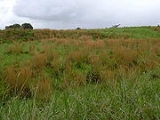
Andropogon virginicus
Encyclopedia
Andropogon virginicus is a species of grass
known by several common names, including broomsedge bluestem and yellowsedge bluestem. It is native to the southeastern United States and as far north as the Great Lakes
. It is known as an introduced species
in California
and Hawaii
, where it is weedy.
, releasing persistent herbicidal chemicals from its dying tissues, such as decaying leaves. A. virginicus colonizes disturbed areas such as abandoned mining
sites. It is a weed of pastures and grazing ranges, where it proves less palatable and nutritious to cattle
than other grasses. This species is tolerant of fire and grows back quickly and more abundantly after a burn. It is perhaps most problematic in Hawaii, where its natural growth patterns are out of synch with the local climate. It is dormant during the Hawaiian rainy season, dying back and leaving the slopes it has colonized exposed and vulnerable to significant erosion
. Despite its weediness, the grass is sometimes grown as an ornamental plant
.
on the wind. This grass is successful in a wide range of habitats. It is a prolific seed producer, it has a high germination
rate and seedling survival rate, and it thrives in poor soils.
Poaceae
The Poaceae is a large and nearly ubiquitous family of flowering plants. Members of this family are commonly called grasses, although the term "grass" is also applied to plants that are not in the Poaceae lineage, including the rushes and sedges...
known by several common names, including broomsedge bluestem and yellowsedge bluestem. It is native to the southeastern United States and as far north as the Great Lakes
Great Lakes
The Great Lakes are a collection of freshwater lakes located in northeastern North America, on the Canada – United States border. Consisting of Lakes Superior, Michigan, Huron, Erie, and Ontario, they form the largest group of freshwater lakes on Earth by total surface, coming in second by volume...
. It is known as an introduced species
Introduced species
An introduced species — or neozoon, alien, exotic, non-indigenous, or non-native species, or simply an introduction, is a species living outside its indigenous or native distributional range, and has arrived in an ecosystem or plant community by human activity, either deliberate or accidental...
in California
California
California is a state located on the West Coast of the United States. It is by far the most populous U.S. state, and the third-largest by land area...
and Hawaii
Hawaii
Hawaii is the newest of the 50 U.S. states , and is the only U.S. state made up entirely of islands. It is the northernmost island group in Polynesia, occupying most of an archipelago in the central Pacific Ocean, southwest of the continental United States, southeast of Japan, and northeast of...
, where it is weedy.
Invasive Species
A. virginicus has also been introduced to Japan and Australia. It competes with other species by allelopathyAllelopathy
Allelopathy is a biological phenomenon by which an organism produces one or more biochemicals that influence the growth, survival, and reproduction of other organisms. These biochemicals are known as allelochemicals and can have beneficial or detrimental effects on the target organisms...
, releasing persistent herbicidal chemicals from its dying tissues, such as decaying leaves. A. virginicus colonizes disturbed areas such as abandoned mining
Mining
Mining is the extraction of valuable minerals or other geological materials from the earth, from an ore body, vein or seam. The term also includes the removal of soil. Materials recovered by mining include base metals, precious metals, iron, uranium, coal, diamonds, limestone, oil shale, rock...
sites. It is a weed of pastures and grazing ranges, where it proves less palatable and nutritious to cattle
Cattle
Cattle are the most common type of large domesticated ungulates. They are a prominent modern member of the subfamily Bovinae, are the most widespread species of the genus Bos, and are most commonly classified collectively as Bos primigenius...
than other grasses. This species is tolerant of fire and grows back quickly and more abundantly after a burn. It is perhaps most problematic in Hawaii, where its natural growth patterns are out of synch with the local climate. It is dormant during the Hawaiian rainy season, dying back and leaving the slopes it has colonized exposed and vulnerable to significant erosion
Erosion
Erosion is when materials are removed from the surface and changed into something else. It only works by hydraulic actions and transport of solids in the natural environment, and leads to the deposition of these materials elsewhere...
. Despite its weediness, the grass is sometimes grown as an ornamental plant
Ornamental plant
Ornamental plants are plants that are grown for decorative purposes in gardens and landscape design projects, as house plants, for cut flowers and specimen display...
.
Life History
A. virginicus is a perennial grass forming narrow clumps of stems up to just over a meter in maximum height. Its stems and leaves are green when new, turning purplish to orange and then straw-colored with age. It produces large amounts of seeds small enough to disperseBiological dispersal
Biological dispersal refers to species movement away from an existing population or away from the parent organism. Through simply moving from one habitat patch to another, the dispersal of an individual has consequences not only for individual fitness, but also for population dynamics, population...
on the wind. This grass is successful in a wide range of habitats. It is a prolific seed producer, it has a high germination
Germination
Germination is the process in which a plant or fungus emerges from a seed or spore, respectively, and begins growth. The most common example of germination is the sprouting of a seedling from a seed of an angiosperm or gymnosperm. However the growth of a sporeling from a spore, for example the...
rate and seedling survival rate, and it thrives in poor soils.

